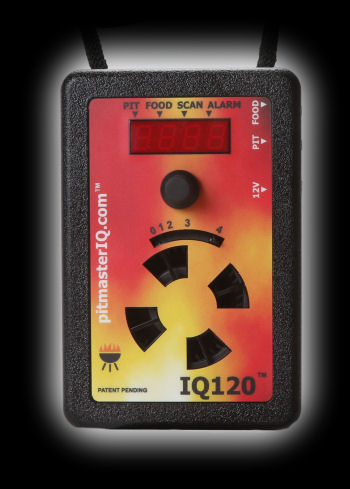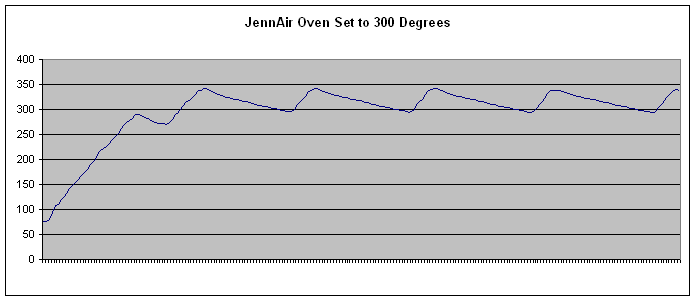 |
 |

Operating The IQ120 Controller
The real test of any temperature controller is how it performs at low temperatures. The reason for this is that the device can only make the cooker hotter. The cooker has to cool off on its own, and a cooker is much more willing to cool off at 450 degrees than it is at 225 degrees. So, the controller has to be a little more subtle and clever to control the lower cooking temperatures so as not to get the fire so hot that the cooker can't cool off fast enough. The IQ120 controller did a good job of controlling temps at low, medium and high temperatures, hitting the targets within few degrees or less and maintaining the targets within a reasonable range. And one last note before we show you the numbers. Since the IQ120 pit temperature display has that 5-degree snap, we couldn't tell the temperature of the cooker using the IQ120 display. Hence, we measured the temperature of the cooker by placing a Thermoworks THS-113-041 bare junction thermocouple about ¼-inch from the tip of the IQ120 temperature probe and recorded values at 30-second intervals. (Normally, we use the temperature readout of the unit being tested.)
As you can see, the IQ120 controller did a good job at low, medium and high temperatures. When initially taking the cooker to the each temperature, there was a varying amount of initial overshoot, from 4.0 to 10.5 degrees, which is much better than we experienced with the IQ110 controller. The unit quickly settled into a cycle that was close to the target and gradually got closer as time went on. (We feel overshoot gets way too much attention, but readers want to know so we measure it. The cooker isn't over the target temperature long enough to really heat up the cooker itself, the temperature drops back down, so what's to worry about?) We did play a bit with the blower damper and we found that using a large Big Green Egg for the cooker, a blower damper setting of 3 worked better than having the blower damper wide open. The overshoot was slightly better and the unit was a bit quicker to settle into its cycle. The results above were from the test using the blower damper set to 3. One other word about starting up your cooker and the IQ120. We found that we got better results if we didn't turn the IQ120 on until we had the fire started and the temperature in the cooker had started to rise. Since the unit will learn the behavior of your cooker, we are going to go out on a limb and guess that it is better if the unit doesn't start learning until the cooker is ready to go. We don't recommend turning the unit on and letting it learn while you are attaching it to the cooker, lighting the fire and placing the probes. Wait until the cooker is behaving like a cooker and then turn the unit on and let it start learning then. While the IQ110 had a greater variation in temperature than we have observed with other controllers, the IQ120 is certainly in the same league as all the other controllers. And of course, we always like to point out that all these controllers provide a level of control which exceeds that which you might think necessary. Compare our results with the IQ120 to your average kitchen oven, which is doing good if it keeps your oven within plus or minus 25 degrees. Even an expensive oven won't come close. We've said this many times, so we'll say it again and show you again how our $2000+ JennAir Dual Fuel Cooker performs when set to 300 degrees. (Since we paid $2000+ for this cooker, we're going to continue flogging this chart for all it is worth.)

$2000 JennAir Temperature Control Results Essentially, our expensive cooker missed the target by 25° with a swing of 25° on either side. Not even close to what the IQ120 can do. A few things we'll point out about using the IQ120 controller:
Summary
pitmasterIQ.com (636) 447-7974
Web: www.pitmasterIQ.com |
You can support this website by shopping at The Naked Whiz Website Store and Amazon.com
|